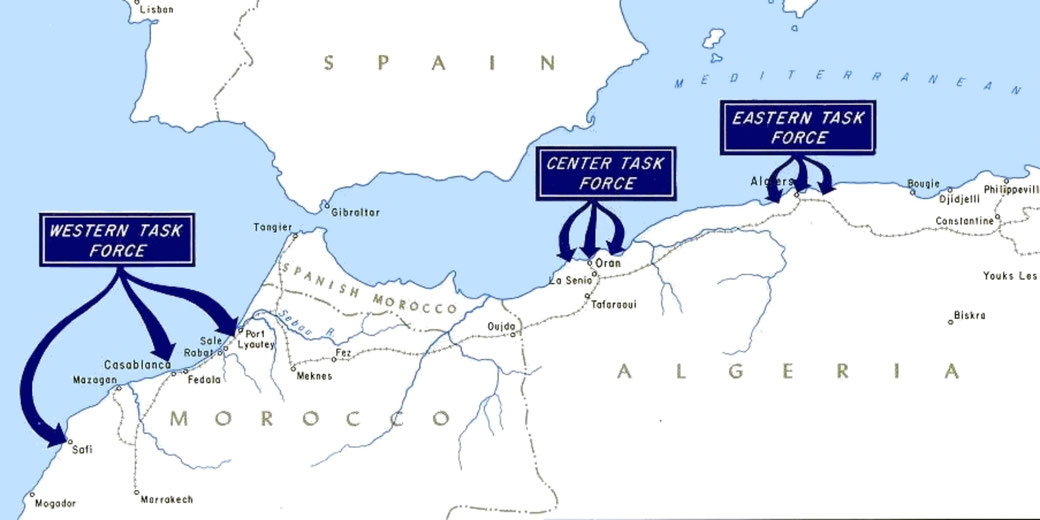Operation Torch: How a risky American invasion of north Africa led to a dramatic shift in WWII

As WWII raged across North Africa in 1942, the Allies launched a massive invasion known as Operation Torch.
Thousands of American and British troops set sail for their first major joint operation to seize control of key ports in French-controlled North Africa and force a foothold in a region critical to both the Axis and the Allies.
But the tension that surrounded those early November landings was palpable.
Victory was certainly not assured.
The situation in 1942
By 1942, the Second World War had reached a critical juncture. The Axis powers, driven by Hitler’s ambitions in Europe and Mussolini’s desire for dominance in the Mediterranean, held large swathes of territory across Europe, North Africa, and the Middle East.
Meanwhile, the Allies, still reeling from setbacks in France and the Pacific, knew that control over the Mediterranean was vital for securing supply routes and blocking Axis expansion into oil-rich regions.
As such, the Middle East had to be defended at all costs, and North Africa became the next logical battleground.
The Axis already held Libya, and Rommel’s Afrika Korps had pushed deep into Egypt, which threatened the vital Suez Canal.
In North Africa, the Vichy French regime controlled Morocco, Algeria, and Tunisia—territories that offered key ports that could serve as staging grounds for further operations into Southern Europe.
For the Allies, gaining control of this region meant opening a new front against the Axis powers and relieving pressure on Soviet forces in the east, where they were locked in a desperate struggle to defend Stalingrad.

How did the Allies plan Operation Torch?
By 1942, American forces joined their British counterparts in planning what would be their first major joint operation in the European theater.
The British had already been deeply engaged in the North African campaign, fighting against Rommel’s forces, who had repeatedly threatened British positions in Egypt.
Together, the Allied powers pooled their resources, troops, and equipment to mount an invasion that would require precise coordination across air, land, and sea.
General Dwight D. Eisenhower, who was appointed the supreme commander of the Allied forces, was tasked with managing the complex logistics of the invasion, which involved multiple landing sites across North Africa.
Working closely with Eisenhower were other key figures, such as Admiral Andrew Cunningham, who was responsible for naval operations, and Air Marshal Sir Arthur Tedder, who oversaw air support.
However, the Allies needed to ensure that the French, who were divided between loyalty to the Vichy government and support for the Free French forces under Charles de Gaulle, would not resist the landings.
To this end, Eisenhower worked closely with diplomats and intelligence officers to manage this delicate situation.
In particular, American diplomat stationed in Algiers, Robert Murphy, negotiated with French officials, which he hoped would minimize resistance.
Why were the French the enemy in North Africa?
In North Africa, Vichy French forces held significant military positions in the colonies of Morocco, Algeria, and Tunisia.
These forces were bound by the armistice signed with Nazi Germany in 1940. This placed them in a complicated position.
Though they were not actively fighting alongside the Axis, they were required to defend their territories against any invasion, including one from the Allies.
They were under the command of Admiral François Darlan and the Vichy French had a considerable number of troops stationed across North Africa.
In Morocco, General Charles Noguès commanded a large garrison, while in Algeria, military strength was concentrated around key cities such as Oran and Algiers.
Despite their formal alignment with Vichy policies, many of these commanders had mixed loyalties.
Even before the invasion, secret negotiations were held with Vichy officials, including Darlan, in an attempt to secure a peaceful surrender.
Robert Murphy and his contacts with Vichy officials in North Africa sought to convince the French that resistance was futile and that collaboration with the Allies was the only viable option.
Unfortunately, the outcome of these talks remained unpredictable.
The invasion force: Where did the Allies land?
Over 100,000 troops from the United States and the United Kingdom were deployed across a vast front that stretched from the Atlantic coast of Morocco to the Mediterranean shores of Algeria.
The American forces, consisting largely of infantry, armored divisions, and support units, formed the bulk of the landing forces.
They were divided into three task forces: the Western, Center, and Eastern Task Forces, each assigned to specific landing sites along the North African coast.
For their part, the British contributed naval support and specialized units, particularly in the Eastern Task Force, where they would face the strongest Vichy French defenses.
At Casablanca, located on the Atlantic coast of Morocco, the Western Task Force—comprising nearly 35,000 American troops—landed under the command of General George S. Patton.
It was the largest of the three landing sites, and they were supported by a powerful naval fleet that included battleships, destroyers, and aircraft carriers.
Meanwhile, over 250 naval vessels provided cover for the landings, bombarding coastal defenses and protecting the transports from potential counterattacks.
Oran, situated further east along the Algerian coast, saw the landing of the Center Task Force, which consisted of about 39,000 American troops under the command of Major General Lloyd Fredendall.
British and American aircraft launched from carriers conducted bombing raids on enemy positions, while warships, including cruisers and destroyers, provided artillery support.
Finally, the Eastern Task Force was made up of 33,000 American and British troops and were to be landed at Algiers.
This force was led by Lieutenant General Kenneth Anderson, with a significant British contingent integrated into the operation.
Algiers was the largest city on the Mediterranean coast, which meant that it was of strategic importance because of its proximity to Tunisia, where Axis forces were already entrenched.
What happened in the battle for North Africa?
On the morning of November 8, 1942, the first waves of Allied forces began landing on the beaches of North Africa as part of Operation Torch.
The initial landings took place simultaneously at three key locations: Casablanca, Oran, and Algiers.
Under the cover of darkness, American and British troops disembarked from their transport ships and waded ashore.
However, the approach to the city of Casablanca by The Western Task Force and General George S. Patton was met with stiff resistance from the Vichy French forces.
Over the next two days, intense fighting ensued as American forces pushed toward the city.
By November 10, the port was firmly in Allied hands, and the Western Task Force had secured one of the most vital objectives of the operation.
Meanwhile, at Oran, the Center Task Force under Major General Lloyd Fredendall encountered stronger resistance than anticipated when they landed on the beaches east and west of the city.
Despite this, by the afternoon of November 8, the Allies had secured a beachhead and advanced toward the heavily fortified port.
French forces launched a series of counterattacks, including an attempt by French naval ships to engage the Allied fleet.
This successfully delayed the capture of Oran, but by November 10, the city’s defenders surrendered.
The fall of Oran allowed the Allies to gain control of its harbor, which quickly became an important hub for unloading reinforcements and supplies in the days that followed.
Algiers, however, became the most significant of the three landing sites.
Lieutenant General Kenneth Anderson’s Eastern Task Force landed east and west of the city and faced sporadic resistance from Vichy French forces.
Despite early skirmishes, a combination of military pressure and political negotiations quickly led to a ceasefire.
By November 9, the French defenders in Algiers had surrendered, allowing the Allies to capture the city with minimal casualties.
The swift fall of Algiers proved critical to the overall success of Operation Torch, as its port provided an essential supply line, and the city’s airfields gave the Allies air superiority in the region.
Ultimately, the resistance did not last long. In less than three days, key commanders at all three sites had agreed to cease hostilities.
Darlan, who was in Algiers at the time, made the choice to order a formal surrender, which was swiftly communicated to French forces across the region.
This was also the beginning of a complex and pragmatic collaboration between the Vichy French and the Allies.
Many Vichy officers chose to align themselves with the Free French forces, while others remained neutral.
The swift surrender of Vichy forces allowed the Allies to focus their efforts on the impending conflict with German and Italian forces in Tunisia.
The impact on the Axis Powers
In response to Operation Torch, the Axis powers, particularly Germany and Italy, were forced to rapidly reassess their strategic position in North Africa.
Until the Allied landings in November 1942, the Axis had maintained a tenuous hold on the region, bolstered by Rommel’s success with the Afrika Korps.
However, the arrival of American and British forces in Morocco and Algeria put immediate pressure on their supply lines and command structure.
Hitler, alarmed by the potential loss of North Africa, ordered the deployment of German reinforcements to Tunisia, hoping to stem the tide and prevent a complete Allied victory.
German forces, including the 10th Panzer Division, were quickly airlifted to Tunisia in an attempt to create a new defensive line.
Also, Hitler increased his commitment to the North African campaign by sending General Hans-Jürgen von Arnim to reinforce Rommel’s command.
The Afrika Korps had already been weakened by supply shortages and heavy losses at the Second Battle of El Alamein.
Even though Rommel had built a reputation as a brilliant and aggressive commander, by early 1943, his position had become untenable, and he was eventually recalled to Europe due to illness, leaving von Arnim in charge of what remained of the Axis forces in Tunisia.
Rommel’s departure marked the beginning of the end for Axis forces in North Africa. Von Arnim, though capable, could not replicate Rommel’s previous successes.
The arrival of fresh American troops and continued British advances placed relentless pressure on Axis defenses.
By May 1943, over 275,000 German and Italian troops in Tunisia had surrendered to the Allies.
The loss of the region meant that the Mediterranean was now fully open to Allied control
What did Operation Torch change?
By securing key ports such as Casablanca, Oran, and Algiers, the Allies gained a foothold that allowed them to push Axis forces out of the region.
German and Italian troops, who had been entrenched in Libya and Tunisia, now found themselves relatively isolated.
The Afrika Korps and their Field Marshal Erwin Rommel were placed under increasing pressure as British forces advanced from the east and newly arrived American forces began to press from the west.
Consequently, Operation Torch was the first large-scale American involvement in the European theater and clearly demonstrated the effectiveness of Allied cooperation.
With North Africa secured, the next logical step was to invade Sicily, which lay just across the Mediterranean.
As a result, Operation Husky would be launched in July 1943, and was a direct result of the success of Operation Torch.
Sicily’s capture would provide the Allies with a critical steppingstone for the invasion of mainland Italy.
Ultimately, the success of Operation Torch set into motion a series of events that shifted the balance of power in the Mediterranean and opened the door to Allied victories in Europe.
What do you need help with?
Download ready-to-use digital learning resources
Copyright © History Skills 2014-2025.
Contact via email
With the exception of links to external sites, some historical sources and extracts from specific publications, all content on this website is copyrighted by History Skills. This content may not be copied, republished or redistributed without written permission from the website creator. Please use the Contact page to obtain relevant permission.





